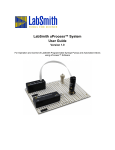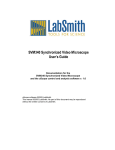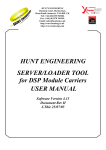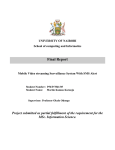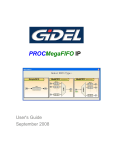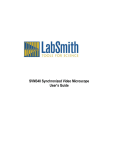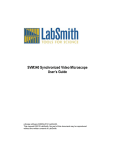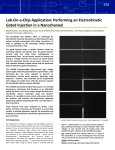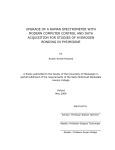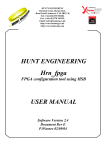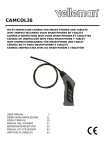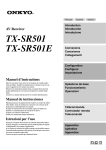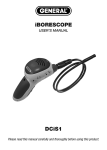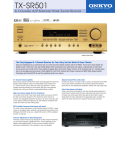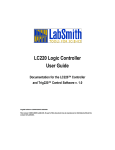Download uProcess User Manual
Transcript
LabSmith uProcess™ System User Guide For Operation and Control of the following LabSmith uProcess devices using uProcess™ Software: SPS01 Programmable Syringe Pumps AV201 Automated Valves AV202 Automated Valves uPS Pressure Sensors 6111 Southfront Rd, Suite E Livermore, CA 94551 925-292-5161(ph) 925-454-9487(fax) www.labsmith.com This manual © 2015 LabSmith, Inc. uProcess software © 2015 LabSmith, Inc. No part of this document may be reproduced or distributed without the consent of LabSmith. LabSmith, CapTite, uProcess and uDevice are trademarks of LabSmith, Inc. CHAPTER 1. INTRODUCTION 4 Equipment List Cautions and Warnings Getting Help About This Manual 5 6 6 6 CHAPTER 2. GETTING STARTED 7 Connecting an Electronic Interface Board Adding a Breadboard Installing Automated Valves Installing Syringe Pumps Installing Pressure Sensors Installing uProcess Software 7 7 8 8 8 9 CHAPTER 3. uPROCESS SOFTWARE 10 Software Interface Communicating with the uDevices Online and Offline Device Naming and Numbering Saving Data into a Log File External Instruments 10 12 16 16 18 18 CHAPTER 4. REAL TIME DEVICE CONTROL 19 uDevice Controls 20 CHAPTER 5. AUTOMATED CONTROL 30 Opening Script Files Create a Script Using the Wizard Save a Script File Run, Pause and Quit a Script Automated Script Functions Editing Automated Script Text Example Script Syringe Pump Volume vs Delivery Time Pressure Regulation Example Scripts 30 30 32 32 34 39 42 48 50 CHAPTER 6. SVM340 AUTOMATION AND CONTROL 55 APPENDIX A. MENUS, TOOLBARS, WINDOW CONTROLS 63 APPENDIX B. MAINTENANCE 66 Updating Firmware Valve Actuation Profile Settings Changing the Syringe Pump Glass Assembly Calibrating the Syringe Pump Care of the Syringe Glass and Plunger 66 66 67 68 69 APPENDIX C. uDEVICE CURRENT CONSUMPTION 71 APPENDIX D. CAPILLARY AND TUBING INSTALLATION GUIDE 72 3 CHAPTER 1. INTRODUCTION LabSmith’s uProcess™ is a platform comprised of a suite of hardware and software products that simplify construction and control of microfluidic systems. uProcess automated devices work together with CapTite™ microfluidic interconnect products to make it easy to build and rebuild micro- and nano-fluidic circuits. All products are intercompatible and quick to assemble, taking the hassle out of fluid routing. SPS01 Programmable Syringe Pumps deliver volumes up to 100 microliters, with resolution as low as 2 nanoliters. The pump body design allows syringes to be easily removed and replaced, providing a wide range of volumes with a single pump. AV201 Automated Selector Valves provide 2-position, 3-port switching, with zero dead volumes and low swept volumes. AV202 Automated Selector Valves provide 2-position, 4-port switching, with zero dead volumes and low swept volumes. AV303 Automated Selector Valves provide 2-position, 6-port switching, with zero dead volumes and low swept volumes. uPS Pressure Sensors provide pressure sensing and regulation. The uProcess Software provides a simple interface for configuring and controlling uProcess devices and for creating automated processes for coordinated control. This user guide will show you how to connect, configure and control uProcess devices, how to install and operate uProcess software, and how to create automated flow control processes. 4AM Analog Manifold uPS01 Pressure Sensor 4VM Valve Manifold BBRES Breadboard Reservoir SPS01 Syringe Pump AV201 Automated Valve EIB200 uPB-05 Breadboard Figure 1. uProcess System Components. 4 Equipment List Required Equipment - PC-compatible computer running Windows® 7 or newer - uProcess Interface (EIB200) - uProcess™ software - installation disk included with EIB purchase 12V power supply for EIB – included with EIB200 purchase - micro-USB cable – included with EIB200 purchase Additional required and optional equipment for syringe pumps - SPS01 Programmable Syringe Pump - SPS01 syringe glass/plunger set – included with SPS01 purchase - CapTite ferrule (C360-100 or T116-100) for connecting to capillary or tubing - syringe glass/plunger installation tools (plunger wrench and 3/32” hex wrench) - installation screws (qty 2 x M3), optional Additional required and optional equipment for automated valves - AV201, AV202, or AV303 automated valve - 4VM01 valve manifold (one manifold per up to four valves) - flat ribbon connector (one per valve) – 4 cables included with 4VM01 purchase - Three (3) CapTite ferrules (C360-100, T132-100, or T116-100) for connecting to capillary or tubing breadboard mounting screws (2-28x1/4”), two per valve, optional - Additional equipment required for pressure sensors - uPS pressure sensor - 4AM01 analog manifold (one manifold per up to four sensors) - flat ribbon connector (one per sensor) –4 cables included with 4AM01 purchase - CapTite component (-C360, -T132, or –T116) with female port for installing sensor Optional Equipment - 20-pin communication cable for direct connection of EIB to uDevice (included with EIB200 purchase) - uPB or iBB breadboard 5 Cautions and Warnings When working with uProcess devices and accompanying electronics, follow standard procedures to protect your devices from excessive static electricity, power fluctuations, etc. Read and understand all documentation for your individual uProcess devices and components before connecting the equipment. CAUTION: Extra care must be taken when using the electronic components with fluids. Breadboards are designed with the electronics mounted on one side; use precautions when introducing liquids to this side of the breadboard. Getting Help This guide is your main source for information on operating uProcess software. Choose Help>About uProcess, then click the Open User Manual link to browse this manual electronically, in Adobe® Acrobat® PDF format. The LabSmith web site (www.labsmith.com) also includes helpful applications notes and other technical information to help you use uProcess software and devices. If you are unable to find the information you need, please contact our technical support team at (925) 292-5161, or email us at [email protected]. Be prepared to give the software version. To determine the software version number, select Help>About uProcess. About This Manual Several conventions are used throughout this manual to highlight important features and concepts: Menu>Option Menu bar selections will be shown in bold text, with descending options separated by the “>” symbol. For example, Help>About uProcess indicates that you should click the Help menu, and then click About uProcess. Note Notes indicate helpful tips or additional information. CAUTION These notes signify important considerations that will help you to avoid losing data or damaging hardware. Italics When browsing the electronic version of this manual, click on these italic crossreferences to view other pertinent sections of the manual. Choose Help>About uProcess, then click the Open User Manual link to browse the electronic version of this manual. Please contact LabSmith or visit www.labsmith.com for user manual, software and firmware updates 6 CHAPTER 2. GETTING STARTED Connecting an Electronic Interface Board Though the devices you use with your uProcess system will vary, some basic hardware is common to all uProcess setups. Every system requires at least one uProcess Interface (EIB200), which can control up to 110 SPS01 Syringe Pumps, 4VM01 Valve Manifolds, and/or 4AM01 Analog Manifolds. Since each manifold can control up to four devices, one EIB200 can thereby control hundreds of devices. Although over 100 devices can be sequentially controlled using a single EIB200, the number of devices simulaneously actuated is limited to approximately 10, based on the current capacity of the EIB200 power supply. See Appendix C for information to calculate the current consumption for a particular setup. Multiple EIB200s can be used at one time when a large number of devices or concurrent operations are required. To connect an EIB200 to the computer: Use the included mini-USB cable to connect the COM port on the EIB200 to the computer’s USB port. Connect the included power transformer from the EIB200 to a wall outlet. The two indicator lights will flash when powered up, after which the Power light will stay illuminated red. The COM light will illuminate when the EIB is communicating with the computer. Adding a Breadboard An EIB200 can be connected to a single syringe pump, valve manifold, or analog manifold; however, it is typically used with one of the LabSmith breadboards (uPB-5, uPB-8, uPB-12, or iBB) for mounting multiple components (Figure 2). Between 5 and 12 uDevices (syringe pumps, valve manifolds, analog manifolds) can be connected to a single breadboard. The EIB200 is connected to the uDevices in one of the following ways: 1. Plugged directly into a slot on a uProcess breadboard (uPB-05, uPB-08-uPB-12,or iBB) 2. Connected to uProcess breadboard via a communication cable. 3. Connected directly to a uDevice (SPS01, 4AM01, or 4VM01) via a communication cable. Note: the standard communication cable provided with the EIB200 can connect only 1 uDevice. Contact LabSmith about obtaining a custom communication cable if connecting multiple uDevices without a breadboard. The larger breadboards (uPB-8, uPB-12, and iBB) can be daisy-chained together by installing a 20-pin communication cable between female connectors on each board. 7 Figure 2. uPB-05 and uPB-08 Breadboards with uDevices. The following sections provide information on installing the various devices available for the uProcess system. Note: disconnect power to the EIB200 before adding or removing devices Installing Automated Valves To install and configure AV201 or AV202 automated valves: Plug the 4VM01 valve manifold into one of the connectors located along the side of the breadboard. Secure the automated valve(s) to the desired location on the breadboard using two ¼” breadboard mounting screws (optional). Use a ribbon cable to connect the automated valve to a port on the valve manifold. Observe the label on the valve and manifold to ensure the cable is connected at the correct orientation. Upon power up, the LED on the 4VM01 will flash red/green and then glow steady green. The valve LED does not illuminate during power up. Installing Syringe Pumps To install an SPS01 programmable syringe pump, plug the syringe pump body into one of the connectors located along the side of the breadboard. Two M3 screws may optionally be used to more securely attach the syringe to the bottom of the breadboard. Upon power up, the LED on the SPS01 will flash red/green and then go out. Installing Pressure Sensors To install and configure uPS pressure sensors: 8 Plug the 4AM01 sensor manifold into one of the connectors located along the side of the breadboard. Secure the pressure sensor(s) to the desired component. Note: the uPS360 sensors can be installed in a –C360 or –T132 CapTite component (for use with 360m OD tubing or 1/32” OD tubing, respectively) The uPS116 sensors can be installed in a –T116 component, for use with 1/16” OD tubing. Use a ribbon cable to connect the pressure sensor to a port on the analog manifold. Observe the label on the manifold to ensure the cable is connected at the correct orientation. Note: the orientation of the connector on the 4AM01 is the opposite of the orientation of the connector on the 4VM01. Connect the ribbon cable to the uPS sensor with the following orientation: Upon power up, the LED on the 4AM01 will flash red/green and then go out. Installing uProcess Software uProcess software runs on any PC-compatible computer running Microsoft Windows® 7, 8, or 10. The software requires approximately 5MB of free disk space. To install uProcess: Insert the uProcess for Windows CD. Double-click SETUP.EXE and follow the on-screen instructions. To run the software, double-click the uProcess icon on your desktop, or choose Run>uProcess>uProcess. The uProcess software can also be downloaded from the LabSmith website (www.labsmith.com) . We recommend visiting the website occasionally to check for software updates. 9 CHAPTER 3. uPROCESS SOFTWARE Software Interface The uProcess Dashboard consists of a menu bar, toolbar, and configurable windows (Figure 3). Unique menu and toolbar commands will be described in the body of the text below. A complete listing of all menu and toolbar commands can be found in Appendix A. Menus, Toolbars, Window Controls. Figure 3. uProcess Dashboard. The uProcess Dashboard consists of 5 windows, described below. You can customize the placement of the windows on the dashboard and a number of other features about the interface. See Customizing the Dashboard for more information. uDevices Window The uDevices Window is used to view, add, and configure individual devices and EIBs (Figure 4). It shares the left side of the Dashboard with the Sequencer Window. Click the tabs at the bottom of this area to switch between the two windows. 10 Figure 4. uDevices Window. Sequencer Window The Sequencer Window is used to view a sequence program (Figure 5). The uDevices Window is used to view, add, and configure individual devices and EIBs. It shares the left side of the Dashboard with the Sequencer Window. Click the tabs at the bottom of this area to switch between the two windows. Figure 5. Sequencer Window. Output Window The Output Window is used to monitor device communications or to debug and monitor a sequence program (Figure 6). By default this window appears at the bottom of the dashboard. 11 Figure 6. Output Window Showing Script Parsing Tab. The Output Window contains three tabs: Script Parsing displays any errors in the current automated process. Sequence Status indicates which process is running and notes any errors incurred. Communications shows the status and history of communication between the Electronic Interface Board and the computer. Main Window The Main Window is used to control and monitor devices, as well as to construct, edit, and monitor sequence programs. Its contents change depending upon what is selected in the uDevices Window or Sequencer Window. The Main Window cannot be undocked or hidden. Communicating with the uDevices Once the uDevice hardware and uProcess software have been installed you are ready to communicate with the devices. Launch the uProcess software. Right-click on Interfaces in the uDevices Window and choose New Interface. Select the computer port to which the EIB is connected, and click OK. If multiple EIBs are installed, repeat this step for each EIB. Your uProcess dashboard should now look similar to Figure 7. 12 Figure 7. uProcess Dashboard. The uDevices Window contains a tree structure listing each EIB and the devices installed under each. In Figure 7 two EIBs are connected. Two SPS01 syringe pumps and a 4VM are connected to the EIB on COM6. A SPS01 syringe pump is connected to the EIB on COM5. Note: Breadboards will not appear as device in the uDevices tab since there are no functions to control on the breadboard itself. With the uDevice window selected, the Main Window will show one of two views: the Control Overview Window or the Individual Device Control Panel. The Control Overview Window allows limited control of all devices. It is also the view that will be used to program sequences using the programming wizard (see Create a Script Using the Wizard). By clicking on one of the individual device names in the uDevices Window, the Individual Device Control Panel opens. Figure 8 shows the control panel for a syringe pump, Figure 9 shows controls for a 4VM01 valve manifold. Figure 9 shows controls for a 4AM01 analog 13 manifold. The Individual Device Control Panel provides a wider range of control and setting options for an individual device than is available in the Control Overview Window. Note: Instructions for using the controls in each of the control panels are given in Chapter 4. Figure 8. Control Panel for Syringe Pump. 14 Figure 9. Control Panel for Valve Manifold. Valves installed in position 1 and 3. Figure 10 Control Panel for Analog Manifold. uPS pressure sensors installed in positions 1, 2, and 3. 15 Online and Offline The communication status of each device is shown in the uDevices Window. To monitor or control a device, the device, its EIB, and the interface must all be online. As shown in Figure 11, the icon to the left of each device will indicate whether it is Offline (not in communication with the computer) or Online (in communication). In this example the EIB on COM11 is offline, and the EIB on COM1 is online. To change the status of a device or EIB, right-click the device in the uDevices Window and check/uncheck the Online setting. To toggle all connected devices to online or offline, click the Online toolbar button Note: . An EIB will go offline if there is a communication error between the COM port and the EIB. Two red lights on the EIB also indicate a communication problem. This error often indicates a bad cable connection. The Communications tab of the Output Window lists the EIB port communication status and history. Figure 11 Devices Shown Offline (EIB on Com11) and Online (EIB on COM1). Device Naming and Numbering Every uDevice (syringe pump, valve manifold, or analog manifold) is identified by an address and name. The uPS pressure sensors also are individually named Note: Clicking on the device name in the uDevices Window will cause the indicator light on the device to flash red/green. This feature aids in quickly identifying each device. Device Address Each device attached to an EIB must be assigned a unique address between 0 and 110. If you purchased several devices at the same time from LabSmith they generally will be preconfigured with unique addresses. Device addresses are shown next to each device in the uDevices Window and also in the Address field of the Individual Device Control Panels. Note: If multiple devices on the same EIB have identical addresses they may not appear in the uDevices Window list, or they may appear as one device. Operating in this condition can cause unpredictable results. If two devices with the same address are installed, one will need to be removed before the address can be changed. 16 Note: The address assigned to each device is independent of its physical position on a breadboard. Devices will be displayed in numerical order on the control panel for each EIB based on the device address, not the position on the breadboard. To change a device address: Select the device in the uDevices Window. Choose Configuration. Select a Device Address from the dropdown menu and click OK. You can also right-click on the device icon in the uDevices Window and choose Change Address. Device Name Your uDevices will arrive with a default name: “LabSmith SPS01” for the syringe pump, “LabSmith 4VM” for the 4VM01; and “LabSmith 4AM” for the 4AM01. You can rename the devices. The name may have a maximum of 16 characters and may not include ‘;’, ‘<’, ‘>’, ‘*’ or ‘=’. Names may include tabs and spaces but may not start or end with them. Names are case-sensitive. If you will be using automated processes, each installed device name must be unique. To change a device name: Select the device in the uDevices Window. Choose Configuration. Type the new device name in the Name field. You can also right-click on the device icon in the uDevices Window and choose Rename. NOTE: Each pressure sensor arrives with the last five numbers of the serial number as the sensor name. The pressure sensor name can only be changed within the 4AM configuration tab (Please see the Analog Manifold Control section of Chapter 4 for information on changing the sensor name). Adding or Removing uDevices To add or remove a device: - Click the Online toolbar button to toggle all interfaces offline. - Physically add or remove the uDevice(s) to or from the breadboard. - Click the Online toolbar button to toggle all interfaces back online. Click the Rescan toolbar button to check for new devices. Any added devices should now appear in the uDevices Window, while any removed devices will be gone. Note: To rescan an individual EIB right-click its icon in the uDevices Window, then choose Rescan Devices. 17 Saving Data into a Log File Time-resolved data can be saved into a data file (format .csv) for later viewing and plotting. Choose File>Log Status/Measurements... to create a Log File. When log file data is being collected there will be a check mark next to the “Log/Status Measurements...” item in the manu. The file will continue to collect data until you uncheck the box, close the software, or change any of the uDevices (add or remove devices). External Instruments The uProcess software supports several third-party instruments. These instruments are connected to the computer via USB or RS-232 connection and, depending on the instrument, can be monitored and/or controlled. Contact LabSmith support ([email protected]) for information and instructions on supported instruments. 18 CHAPTER 4. REAL TIME DEVICE CONTROL uProcess lets you control connected devices manually or as part of an automated process. uDevice control can be accessed two ways: through the Control Overview Window (accessed by clicking on the Interfaces heading in the uDevices window) or through an individual Device Control Panel, which can be accessed by clicking on the device name in the uDevices window Click to access Control Overview Window Click an individual device to access its Device Control Panel The Control Overview Window gives you a convenient way to view and set the controls for multiple devices, which is particularly useful when setting up the steps of an automated process, or when controlling multiple devices via pressure regulation. Figure 12 shows a typical Control Overview Window. The individual Device Control Panels can be selected for additional controls for the particular devices. 19 Figure 12 Example of Control Overview Window uDevice Controls Individual uDevices can be controlled via the Device Control Overview Window (shown in Figure 12) or via its individual Device Control Panel. The controls for each type of uDevice are described below. Analog Manifold Control The analog manifold controls are used to monitor and control the uPS pressure sensors. Typical Control Overview Window and Analog Manifold Control Panel views are shown in Figure 13 and Figure 14, respectively. Figure 13 Typical Control Overview Window view of analog manifold controls. 20 4AM name sensor name pressure reading regulation pressure ambient temperature regulation status indicators slider bar scale Figure 14 Typical Analog Manifold Control Panel view. The following commands and information are available for each connected uPS pressure sensor: 4AM01 Name Set name for the 4AM01 Sensor Name Set name for the pressure sensor (see ‘4AM and Sensor Configuration Settings’ for instructions on changing sensor name) Pressure Reading Current sensor pressure reading Regulation Pressure The regulation pressure can be set by moving the slider bar, or by typing the desired pressure in the pressure reading box Temperature* This is the pressure sensor ambient temperature (not the fluid temperature). Scale* Indicates pressure scale for slider bar (see ‘4AM and Sensor Configuration Settings’ for instructions on changing scale) * temperature and scale are not displayed in the Control Overview Window Pressure Regulation Regulation Status Indicators show the current regulation status (regulating up, regulating down, regulation satisfied, unregulated). See Channel Regulation below for more information. Clicking on “Reg..” or “Regulate...” brings up the Regulation Settings Window, as shown in Figure 15. From this window you can set the regulation target reading and choose a hardware channel to output the regulation status. 21 Figure 15 Regulation Setting Window The following options are available for the Regulation Settings Window: Target reading: input target pressure value in specified units Check too low: the sensor will regulate up to the input value Check too high: the sensor will regulate down to the input value, when the actual pressure is equal to or below the target reading the regulation will be complete. Tolerance: input +/- tolerance for target reading. the sensor will regulate until the pressure value is within the target +/- tolerance Hysteresis: checking this option causes the pressure to regulate to the extreme of the target +/- tolerance, and then the regulation stops until the pressure drifts to the opposite tolerance level Note: the tolerance and hysteresis options are only activated if both check too low and check too high are selected. Channel Regulation: check the box and select the channel to send the regulation status to an EIB hardware channel. Channel regulation can be used to couple the pressure sensor to a SPS01 syringe pump or automated valve to actuate the syringe or valve based on the pressure regulation status. 22 If a hardware channel is selected, the channel status will be shown on the EIB control window and the analog sensor panel. Regulation Status Indicators include: Regulating Up Regulation satisfied Regulating down Unregulated Regulation pending, but not set For the example shown below: uPS 0041 is unregulated uPS 073X is regulating up and set to hardware channel B uPS 066S is pending, but not set so the regulation type is unknown (the user would press ‘apply settings now’ uPS 072X to set the programming) is regulating down and is set to hardware channel C 4AM01 and Sensor Configuration Settings Several configuration settings are available to optimize performance of the 4AM01 and pressure sensors. Click on the ‘Configuration…’ button of the 4AM01 device window to open the Configure LabSmith 4AM window shown in Figure 16. 23 Figure 16 4AM01 Configuration Settings The gain setting is used to optimize the gain for device and scale range of interest. For the uPS pressure sensors, the gain readings should be applied as follows: Off: does not sample sensor x1: not applicable for uPS pressure sensors x20: for full-scale pressure readings (default for uPS pressure sensors) x200: for applications where the pressures will be up to a max of ~10% of full scale Therefore, for a uPS01-800 pressure sensor, if the measured pressures are expected to be less than 80 kPa, use the x200 gain setting for the most accurate results. The default sampling rate is 1.8 kS/s. This rate has the lowest noise and will be suitable for most applications. Zero Offset The zero reading on the pressure sensors will drift slightly (typically less than ~+/-2 kPa) over time, especially if there are large swings in the sensor temperature. We recommend that you occasionally re-zero the sensors to eliminate the zero offset. Procedure: 1. Power up the sensors and 4AM and wait for about 5 minutes for the 4AM to warm up. 2. Click on each sensor to bring up its Sensor Properties window (Figure 17) 3. Click the ‘Zero Reading’ button to zero the pressure sensor. 24 Figure 17 Sensor Properties Window Note: adjusting the zero offset from this Sensor Properties window will preserve the original factory calibration. The sensor offset can also be adjust from the main menu at Action>Sensor Calibration>Tare/Set Current Reading. Adjusting the offset from this menu will change the calibration file data. The Sensor Properties Window provides the following additional controls Sensor Name: the default name is the last 5 numbers of the Sensor serial number Display Units: default units are kPa, a conversion factor can be input to display the pressure in units other than kPa Display limits: these are the limits displayed in the Control Overview Window and the Analog Manifold Control Panel Calibration: the pressure sensors are shipped with a factory calibration, please contact LabSmith before changing the calibration Factory Settings: please contact LabSmith before changing the factory settings Syringe Pump Control Syringe pump control of the set volume and flow rate, and the pressure regulation settings can be manipulated via the Device Control Overview Window, as shown in Figure 18. The Syringe Pump uDevice Control Panel (Figure 19) provides additional position control options and Configuration settings. 25 uDevice name max volume set volume pressure regulation actual volume min volume set flow rate motion indicator min flow rate max flow rate Figure 18 Syringe pump control options in the Device Control Overview Window access configuration settings syringe size (can be adjusted in Configuration...) Move in increments (max, 10%, 1%, 0.1% of range) Move in increments of... Figure 19 Additional syringe pump control options available in the Syringe Pump uDevice Control Panel. Target Volume is set by dragging the volume slider, or entering the desired volume in the Target volume box. Flow Rate is set by dragging the flow rate slider, or entering the desired rate in the Flow rate box. Note: If Update All uDevices Continuously ( ) is selected, changes in target volume or flow rate are immediately applied. If not selected, the pump settings will not change until Apply All Settings Now ( ) or is selected. The Motion Indicator shows the pump motion 26 green indicates that the pump is pushing red indicates that pump is pulling grey indicates the pump is stationary a red X next to the syringe tip indicates the pump is stalled The syringe pump can be used to regulate pressure by clicking on the Set motion via Ch. until the desired Channel setting is selected. The Channel Setting options are: Move with Ch. X Syringe pump will “push” when pressure on Ch X is below the desired setting. Syringe pump will “pull” when pressure on Ch X is above the desired setting. Move opp. Ch. X Syringe pump will “pull” when pressure on Ch X is below the desired setting. Syringe pump will “push” when pressure on Ch X is above the desired setting. Note:. Clicking on the target volume input box or moving the volume slider will disable the pressure regulation. See Analog Manifold Settings for more information on regulating a uPS pressure sensor via a channel setting. Optimizing Syringe Pump Performance The syringe pump is designed for optimal accuracy in the push (infuse) direction. The pump motor design includes an anti-backlash spring, which can cause minor volume inaccuracy in the pull direction. In addition, when changing the syringe direction from pull to push, or vice-versa, you may notice a slight delay before the syringe plunger starts advancing. The volume inaccuracy and duration of the delay will vary depending on the syringe size, set speed, system back pressure, and fluid viscosity. To improve the timing and volume accuracy of an infusion we recommend pushing a small volume of fluid prior to starting the timed infusion. For example, if you want to pull 10 ul of fluid from a reservoir and then push (infuse) it into a process, we recommend pulling 11 µl of fluid, then push 1ul back into the reservoir before switching your valve to the infuse position. Valve Manifold Control Click a valve manifold in the uDevices Window to view its control panel (Figure 20). 27 Figure 20. Controls for a 4VM01 valve manifold with AV201 or AV202 automated valves. The valve can be actuated to three positions(see Figure 21) as shown below. No change The valve state will not change, indicated as position “0” in script. A The valve will allow flow to the left, indicated as position “1” in script. Closed The valve will close, indicated as position “2” in script. B The valve will open flow to the right, indicated as position “3” in script. AV201 Series (3-port) valve AV202 Series (4-port) valve Figure 21. Shows the valve flow positions, looking down from the front of the valve. The indicator lights on the valve will illuminate when it is being actuated. A red light indicates that it is being actuated to the “A” position, while a green light indicates it is being actuated to the “B” position. If the current valve state is known, there will be a check next to the state and the message below the valve will read “In position”. If the current valve state is unknown (i.e. if power to the EIB has been cycled), none of the check boxes will be marked and the message below the valve will read “Indeterminate”. NOTE: If valve cables are switched while the EIB is powered, the valve states could be incorrectly indicated. Remove power to the EIB before changing valves or moving cables. If Update Continuously is selected, the valve will move immediately when you select a new position, and the check mark to the right of that position will be marked. When Update Continuously is not selected, choose the new position, then click Apply Settings Now to move the valve (the check mark for the new position will be then marked). The valve can also be instructed to set based on channel regulation status. 28 or Set via Ch. The valve will change states based on the regulation status (see Chapter 5). If the valve is selected to move “With” the channel the default valve positions are: Regulating up (pressure is too low): valve will move to position “B” Regulation achieved (pressure is within range): valve will move to position “Closed” Regulating down (pressure is too high): valve will move to position “A” If the valve is selected to move “Opposite” the channel the default valve positions are: Regulating up: valve will move to position “A” Regulation achieved: valve will move to position “Closed” Regulating down: valve will move to position “B” 29 CHAPTER 5. AUTOMATED CONTROL An automated script is a series of steps for controlling one or more automated devices. Each step can change the state of multiple devices. A script can be created using the Process Wizard, and it can be created or edited using the built-in text editor. Opening Script Files Each automated script is stored as a file with a .usq extension. To open an existing script click the Open toolbar button, then browse for the correct file. Its contents will appear in the Main Window (Figure 22). Figure 22. Text of an Automated Process. Create a Script Using the Wizard The uProcess Wizard provides a simplified interface for quickly generating automated scripts. Note: Each installed syringe pump and 4VM01 must have a unique name, regardless of whether it is used in an automated script. See Device Name. To create a script using the uProcess Wizard: 1. Click Interfaces to view the Control Overview Window. 30 2. Ensure the ‘Update all uDevices Continuously’ button ( selected, press the stop button to unselect ( ) is NOT selected. If ) 3. Select the action for the first step. For example, turn valve 1 to ‘A’ and valve 2 to ‘Closed’. 4. Click the Save as New Sequence Step button ( Step dialog box will open (Figure 23). ). The Creating a New Sequence 5. 31 Figure 23. Creating a New Process Step Dialog Box. If desired, enter a descriptive Step Name. Step names may have a maximum of 16 characters and may not include blanks or ‘;’, ‘<’, ‘>’, ‘*’ or ‘=’. Select how the script should respond after changing the uDevice settings: Select Pause, then enter the duration to pause before continuing with the process. The pause duration begins as soon as the step starts. If you select Wait until all devices are finished, uProcess will wait until all devices have completed their functions before continuing on with the process. Select Do Not Wait to immediately continue on to the next step. Select how the script should continue after this step: Select Continue to continue to the next step in the process. If a new step is not added the process will end. Select Loop to step to jump to another process step. Select the target step from the drop-down list, then enter the number of times the step should loop (if 0 is entered loop will be infinate). Click OK. The step will appear in the Sequencer Window, and its text will appear in the Main Window. Save a Script File Click the Save toolbar button, or choose File>Save, to save all changes to the current script file. If the file has not yet been saved you will be prompted to provide a name and file location for it. Choose File>Save As to store the current script under a new file name. Run, Pause and Quit a Script When a script is open and error-free, the Run toolbar button will be available. Click Run to initiate the process. All steps will be performed in order. 32 While a script is running you can click the Pause toolbar button to pause the automated process. Click Pause again to continue the script from that point. Click the Quit Process Note: toolbar button to quit running the automated script. When you Pause or Quit a script, devices that were moving will continue until they reach their target states. Click the Stop All Devices device activity. toolbar button to stop all While an automated script is running, the Sequence Status tab of the Output Window will indicate the current status of the script and will report any errors encountered (Figure 24). Figure 24. Sequence Progress Tab of the Output Window . 33 Automated Script Functions Beep: <Beep> Plays an audible sound (the sound associated with the asterisk in System Sounds). Example: <Beep> Note: Break The Beep function cannot be added using the Process Wizard. <Break> Automatically activates the pause toolbar button, pausing Sequence until the pause toolbar button is pressed. This function is useful for testing a script, or if you have an event with unpredictable timing that needs to be controlled manually. Example: <Break> Note: Goto The Break function cannot be added using the Process Wizard <Goto> StepName Creates a loop back to named step. StepName Example: HysteresisReg defined name of step in script <Goto> FillStep DeviceName: HysteresisReg Pmin Pmax units Regulates between two pressures. If pressure starts below regulation range, uProcess will regulate up to Pmax and then let the pressure drift down to Pmin. If pressure starts above regulation range, uProcess will regulate down to Pmin and then let the pressure drift up to Pmax. DeviceName: Pmin: Pmax: units: defined name of uPS pressure sensor (must be defined in script header) minimum pressure in range maximum pressure in range pressure units Example: HysteresisReg 40.000 60.000 kPa HysteresisReg to Channel DeviceName: HysteresisReg Pmin Pmax units to ChX Similar to HysteresisReg, except it sends the output value to a specified channel that can be used to control a SPS01 syringe pump. Requires two lines of code: DeviceName: HysteresisReg Pmin Pmax units to ChX SyringeName: MoveWith ChX or SyringeName: MoveOpposite ChX DeviceName: defined name of uPS pressure sensor (must be defined in script header) Pmin: minimum pressure in range Pmax: maximum pressure in range 34 units: pressure units SyringeName X defined name of syringe pump (must be defined in script header) channel A, B, C, or D MoveWith ChX: pulls the syringe to decrease the pressure pushes the syringe to increase the pressure MoveOpposite ChX: pushes the syringe to decrease the pressure pulls the syringe to increase the pressure Example: HysteresisReg 40.000 60.000 kPa to ChA SPS01: IfDone MoveWith ChA DeviceName: IfDone If regulation is finished, the immediately following step will be executed; otherwise, the immediately following step will be skipped. DeviceName: defined name of uPS pressure sensor (must be defined in script header) Example: Note: IfNotDone uPS1 : IfDone <Beep> The IfDone function cannot be added using the Process Wizard DeviceName: IfNotDone If regulation is not done, the immediately following step will be executed; otherwise, the immediately following step will be skipped. DeviceName defined name of uPS pressure sensor (must be defined in script header) Example: Note: Log uPS1 : IfNotDone <goto> Step1 The IfNotDone function cannot be added using the Process Wizard <log> on optional filename <log> off Opens/closes a log file. filename: file path and name (see examples) if omitted, file naming will be as specified in View>Status/Meas Logging Options… Note: if the file name or path contains a space, the entire name and path must be surrounded by double quotes (see example) Note: a Scrip Error will occur and the script will halt if a <log> on command is issued when a log file is already open or a <log> off command is issued when a log file is not open 35 Examples: <log> on <log> on C:\Temp\testlog.csv <log> on "C:\Temp\test log.csv" Loop <Loop> StepName cycles Loops back to named step for specified number of cycles. StepName: defined name of step in script cycles: number of times to loop; Example: <Loop> FillStep 6 Note: For an endless loop, use the <Goto> command. MoveTo SyringeName: MoveTo vol units Sets the desired syringe position. SyringeName vol units Example: Pause defined name of syringe (must be defined in script header) desired syringe volume volume units, acceptable units include ul (default) ml nl Reagent: MoveTo 20.5 ul <Pause> duration units Pauses script for specified duration. Duration units Example: length of pause pause duration units, acceptable units include ms (default) s us <Pause> 1 s SetFlowRate SyringeName: SetFlowRate rate units; Sets syringe flow rate. SyringeName rate units Example: 36 defined name of syringe (must be defined in script header) syringe flow rate (positive number) flow rate units, acceptable units include ul/min (default) ul/s nl/min nl/s Reagent: SetFlowRate 50 ul/s SetValves 4VM01Name: SetValves x x x x Sets valve positions. 4VM01Name xxxx defined name of 4VM01 (must be defined in script header) position of valves 1, 2, 3, and, 4, respectively, where x = 0 no change x = 1: open valve to ‘A’ x = 2: close valve x = 3 open valve to ‘B’ Example: 4VM01_A: Stop SetValves 1 0 3 2 DeviceName: Stop Stops device. DeviceName defined name of 4VM01 or syringe (must be defined in script header) Example: Reagent: Stop Note: The Stop command is added via the Process Wizard using the this uDevice) in the Device Control Overview window. Quit button (Stop <Quit> Quits the script, steps following this function will not be run. This function will not stop a device that is already in process, for that use the Stop function. Example: <Quit> Note: The Quit function cannot be added using the Process Wizard. RegDownTo and RegUpTo SensorName: RegDownTo value units; regulation is complete when sensor pressure reaches or drops below input value or SensorName: RegUpTo value units; regulation is complete when sensor pressure reaches or exceeds input value SensorName value units Example: defined name of sensor (must be defined in script header) pressure (positive or negative number) pressure units, acceptable units: kPa P032: RegDownTo 50 kPa 37 RegDownTo Channel or RegUpTo Channel Similar to RegDownTo and RegUpTo, except it sends the output value to a specified channel which is used to control one or more SPS01 syringe pump. Requires two lines of code: SensorName: RegDownTo value units to ChX SyringeName: MoveWith ChX or SyringeName: MoveOpposite ChX or SensorName: RegDownTo value units to ChX SyringeName: MoveWith ChX or SyringeName: MoveOpposite ChX SensorName value units defined name of sensor (must be defined in script header) pressure (positive or negative number) pressure units, acceptable units: kPa SyringeName X defined name of syringe pump (must be defined in script header) channel A, B, C, or D MoveWith ChX: pulls the syringe to decrease the pressure pushes the syringe to increase the pressure MoveOpposite ChX: pushes the syringe to decrease the pressure pulls the syringe to increase the pressure Example: P032: SPS01: RegDownTo 50 kPa to ChA MoveWith ChA Note: Use the SetFlowRate command to set the syringe pump flow rate for each syringe, else the last flow rate set for the syringe will be used. RegOff SensorName: RegOff Turns off the regulation for a pressure sensor. Example: 032: RegOff WaitAllDone <WaitAllDone> Pauses script until all processes are complete. Example: 38 <WaitAllDone> General Formatting Rules Devices Individual devices are defined in the script as follows: Syringes: *DeviceName = SPS01 size ul Where size is the syringe size (4, 8, 20, 40, or 80) Valve Manifolds *DeviceName = 4VM01 DeviceName must match name defined in the uDevice configuration (see Device Naming and Numbering). Note: When referring to a device in the script the device name cannot start in the first column of a row. Insert a space or tab before the name. Comments Comments can be added to the script using a semicolon (;). Anything after the semicolon is treated as a comment: <Pause> 1000 ms; to allow time to monitor reaction ; <Beep> - this command will not be executed Step Name Step names may have a maximum of 16 characters and may not include blanks or ‘;’, ‘<’, ‘>’, ‘*’ or ‘=’. The Step Name must start in the first column of a row, do not add a space or tab before a step name. Editing Automated Script Text As mentioned earlier, you can create a script using the Process Wizard, or you can create/edit the text directly. To view and edit the text of a script, click on the Sequencer window, then select Sequencing Script. The text will appear in the Main Window. Here is a sample script: 39 *Syringe= SPS01 20 ul *Manifold= 4VM01 Open_Reservoir Manifold: SetValves 1 0 0 0 <WaitAllDone> Fill_Syringe Syringe: SetFlowRate 50 ul/min Syringe: MoveTo 10 ul <WaitAllDone> Open_Process Manifold: SetValves 3 0 0 0 <Pause> 1000 ms Deliver_Reagent Syringe: SetFlowRate 10 ul/min Syringe: MoveTo 0 ul <WaitAllDone> <Loop> Fill_Syringe 10 The first lines define the devices used in the script. Note that the devices are defined by name rather than address, so the names of all devices must be unique. Below these declarations, each step is listed in order. For clarity, all state changes within each step are indented below the step name. When learning to edit the text it may prove helpful to create a script using the Wizard, then to edit the generated text as the basis for your new script. Most standard text editing functions are available, including Cut, Copy and Paste. Script Errors uProcess will review the script as you create or edit it and will indicate errors as follows: If the script has an error the Run button will be grayed out and the script cannot be run. The Script Parsing tab of the Output window will display the message ***The script cannot be run until the script errors are resolved*** The Script Parsing tab of the Output window will also list the line number and specific error. The step with the error will show a “broken” icon in the Sequencing Script list. In the example shown in Figure 25, line 36 has an error. Device ‘water’ is not found, because the device was initialized as ‘Water’. 40 Figure 25. Sample script showing errors in line. Missing Devices All of the devices referenced in a process must be available for the process to function. If you open or create a script which calls out a device that is not present, error messages will appear in the uDevices Windows, the Script Parsing tab of the Output Window, and the Main Window (Figure 26). 41 Error Messages Figure 26. Error Message: Referencing a missing device. For this example, the script references “Dye”, but the syringe is named “Water”. This error can be resolved by renaming the device (see Device Naming and Numbering) or changing the script. To change the script: Right click on “Dye” under the Missing devices tab and select Rename … Change the name to “Water” and click OK. Example Script In the example shown in a syringe pump is attached to an automated valve, a supply reservoir and a downstream process. The syringe will first pull fluid from a reservoir connected to the “A” port of the valve. The valve will then switch to the “B” position, and the syringe will deliver the fluid to the downstream process. 42 Figure 27. Hardware Setup for the Sample Process. For this example the following devices are installed on one EIB: - One 20µl syringe named “Reagent Syringe” - One 4VM01 manifold named “Reagent Manifold”, with one valve connected at position 1 Rename the 20µ syringe to “Reagent Syringe” and the 4VM01 manifold to “Reagent Manifold” by right clicking on the device icon in the Devices Window and choose ‘Rename’. In general, the name may have a maximum of 16 characters and may not include ‘;’, ‘<’, ‘<’, ‘*’, or ‘=’. Names may include tabs and spaces but may not start or end with them. Names are case sensitive. The automated script is created as follows: In the uDevices Window select Interfaces to display the Device Control Overview Window (). Figure 278. Installed Devices Shown in Device Control Overview Window. 43 Set the position for Valve 1 on “Reagent Manifold” to Open A. Depress the Do Not Change uDevice Settings Click the Save As a New Sequence Step button next to the Reagent Syringe. button. Name the new step “Open_Reservoir”. Select ‘Wait until all devices are finished’ and ‘Continue’. Click OK to add this step to the script and go on to the next step. Set the Target Volume for the syringe named “Reagent Syringe” to 10 µl and the Flow Rate to 50 µl/min (). Figure 29. Step “Fill_Syringe” Settings. Depress the Do Not Change uDevice Settings Click the Save As a New Sequence Step Name the new step “Fill_Syringe”. 44 button next to the Reagent Manifold. button. Choose ‘Wait until all devices are finished’ and ‘Continue’ (). Figure 30. Step 1 Settings. Click OK to add this step to the script. To view the process thus far, click the Sequencer Window tab then click on any step in the sequencing script (). Select Interfaces in the uDevices Window to return to the Device Control Overview Window and continue building the script. Figure 31. Step 1 Shown in the Sequence Tab and Main Window. 45 Set the position of Valve 1 to Open B and depress the button for the Reagent Syringe. Click the Save As a New Sequence Step button and name the new step “Open_Process”. Choose Pause and set the time for 1 s (1000 ms). Choose Continue and select OK to go on to the next step. Set the Target Volume to 0 and the Flow Rate to 10ul/min and depress the Reagent Manifold. button for the Click the Save as a New Sequence Step button. Name the step “Deliver_Reagent”. Select ‘Wait until all devices have finished’. Select Loop to Step and choose Open_Reservoir from the drop down menu. Set the loop count to 10, and the process will repeat for 10 iterations. (). Figure 32. Deliver_Reagent Step Settings. Click OK. Again, select the Sequencer Window tab and click on a step in the script to view the complete script (). 46 Figure 33. The Complete Example Script. Press the Run button to initiate the automated script. When a script is running, the current step will highlighted in the Main Window to allow tracking of the script progress. The status of the devices and the step progression can be monitored real time. As shown in the figure below, the Device Control Overview Window shows the real time positions of the syringes and valves; the Sequence Status tab of the Output Window shows which step is currently running and the number of iterations which have been completed. The bottom left corner of the window shows how long the script has been running (). 47 Figure 34. Sequence Status Tab Syringe Pump Volume vs Delivery Time In the above example the syringe is set to deliver 10 µl of reagent at 10 µl/min. In order not to overshoot the delivery of the reagent, the syringe will slow down just before reaching the target volume; therefore, the delivery time may be more than 1 minute. This is most pronounced when delivering at high flow rates. For some processes the infuse time may be more critical than the total delivery volume. For this case you can use the <Pause> and <Stop> functions together to set the infuse time. The script from the above example is shown below. In this script, the syringe is called “Syringe” and the 4VM01 manifold is called “Manifold”. 48 *Syringe = SPS01 20 ul *Manifold = 4VM01 Open_Reservoir Manifold: SetValves 1 0 0 0 <WaitAllDone> Fill_Syringe Syringe: SetFlowRate 50 ul/min Syringe: MoveTo 10 ul <WaitAllDone> Open_Process Manifold: SetValves 3 0 0 0 <Pause> 1000 ms Deliver_Reagent Syringe: SetFlowRate 10 ul/min Syringe: MoveTo 0 ul <WaitAllDone> <Loop> Fill_Syringe 10 The total volume delivered is 10 µl, which at 10 µl/min should take approximately 1 minute. If a delivery time of exactly 1 minute is desired, the script could be modified as follows (changes are in bold): *Syringe = SPS01 20 ul *Manifold = 4VM01 Open_Reservoir Manifold: SetValves 1 0 0 0 <WaitAllDone> Fill_Syringe Syringe: SetFlowRate 50 ul/min Syringe: MoveTo 11 ul ; provide extra volume so the ; syringe won’t stop prematurely <WaitAllDone> Open_Process Manifold: SetValves 3 0 0 0 <Pause> 1000 ms Deliver_Reagent Syringe: SetFlowRate 10 ul/min Syringe: MoveTo 0 ul ;<WaitAllDone> this command is commented out <Pause> 60 s ;allow the syringe to run for 60 s Syringe: Stop ;stop the syringe <Loop> Fill_Syringe 10 In the second example the syringe is instructed to stop after exactly 60 seconds, which will be after approximately 10 l is delivered. 49 Pressure Regulation Example Scripts The uPS pressure sensors and SPS01 syringe pumps can be used together with the uProcess software to regulate the pressure in a device or create pressure driven flow. In the simple pressurization example below, the SPS01 syringe pump is filled from the reservoir, and then it is used to pressurize a device. When the pressure reaches 100 kPa the script is complete. Valve 1 reservoir SPS01 uPS Simple pressure regulation application (uPB-05 breadboard, 4VM manifold, and 4AM manifold not shown for clarity) In order to rename the pressure sensors, click on 4AM in the uDevices window under Interfaces. In the main window, click on ‘Configuration’. This will open up a new dialogue box. Click on ‘Sensor 1’ to edit the name of the first sensor. This will open another dialogue box. In the box under ‘Sensor Name’ put in the new name. In this script, the sensor is called ‘uPS’. Remember the name is case sensitive. 50 Simple Pressure Regulation Example Script *SPS01 *uPS *4AM *4VM = = = = SPS01 80 ul uPS01 800 kPa 4AM01 4VM01 Switch_Fill 4VM: 4VM: ; switch valve to “fill” position SetValves 1 0 0 0 WaitDone Fill ; fill syringe with liquid from reservoir SetFlowRate 150 ul/min MoveTo 80 ul WaitDone SPS01: SPS01: SPS01: Switch_Dispense ; switch valve to “dispense” position 4VM: SetValves 3 0 0 0 4VM: WaitDone Pressurize uPS: RegUpTo 2 kPa SPS01: SetFlowRate 20 ul/min SPS01: MoveTo 0 ul uPS: WaitDone SPS01: Stop ; stop the syringe pump 4AM: Stop ; stop the regulation One potential issue with the above script is if the syringe reaches end before the pressure <Beep> ; indicate script is the complete reaches 2 kPa the script will never complete. To account for this condition, the last step (“Pressurize”) can be changed to include a loop that looks to see whether the syringe has finished. If the syringe finishes before the pressure is reached, the valve switches back to the reservoir to refill the syringe and then the device is pressurized again. This script is shown below. 51 Pressure Regulation Example Script with auto re-fill of syringe if pressure is not reached *SPS01 *uPS *4AM *4VM = = = = SPS01 80 ul uPS01 800 kPa 4AM01 4VM01 Switch_Fill 4VM: 4VM: ; switch valve to “fill” position SetValves 1 0 0 0 WaitDone Fill ; fill syringe with liquid from reservoir SetFlowRate 150 ul/min MoveTo 80 ul WaitDone SPS01: SPS01: SPS01: Switch_Dispense ; switch valve to “dispense” position 4VM: SetValves 3 0 0 0 4VM: WaitDone Pressurize uPS: SPS01: SPS01: RegUpTo 100 kPa SetFlowRate 20 ul/min MoveTo 0 ul Check_Loop SPS01: <Goto> uPS: <Goto> <Pause> <Goto> ifdone Switch_Fill ifdone Finish 1 s Check_Loop Finish SPS01: Stop ; stop the syringe pump Pinched Flow Example Script with Pressure Regulation 4AM: Stop ; stop the regulation The uProcess system can also be used to create near-constant pressure flow, as shown in the <Beep> ; indicate script is complete following pinched flow application example. Fluorescent dye is injected in the main leg of a cross chip and water is injected in the two cross arms to create pinched flow across the width of the channel. A reservoir (BB_RES) out fitted with an o-ring and cap is placed upstream of each chip inlet. Each reservoir is partially filled with the corresponding liquid (dye or water), leaving an air gap at the top to allow flow dampening. A uPS pressure sensor is installed in the cap of the reservoir to monitor and regulate the pressure. 52 Pinched Flow Waste Valve 1 Dye_80 Cross chip Dye Water_80 reservoir with uPS_1 Valve 2 Water Y interconnect (splitter) reservoir with uPS_2 Pressure regulated hydrodynamic flow application (iBB breadboard, 4VM manifold, and 4AM manifold not shown for clarity) The script below will: 1. Switch_Fill: open the valves to the open reservoirs; 2. Fill: fill the syringes; 3. Switch_Dispense: open the valves to the chip; 53 4. Regulate: dispense the syringe fluids toward the chip DYE a. Dye_80 syringe dispenses until reservoir_1 pressure reaches 46 kPa b. Dye-80 syringe stops, pressure monitored until pressure drops below 45 kPa c. water dispense until reservoir_2 pressure reaches 37.5 kPa *uPS_1 = *uPS_2 = *Dye_80= *Water_80 = *4AM = *4VM = uPS01 uPS01 SPS01 SPS01 4AM01 4VM01 800 kPa 800 kPa 80 ul 80 ul Switch_Fill 4VM: 4VM: Fill Water_80: Water_80: Dye_80: Dye_80: Water_80: Dye_80: ; switches valves to “fill” position SetValves 3 3 0 0 WaitDone ; fills syringes with liquid from reservoirs SetFlowRate 150 ul/min MoveTo 100 ul SetFlowRate 150 ul/min MoveTo 100 ul WaitDone WaitDone Switch_Dispense ; switches valves to “dispense” position 4VM: SetValves 1 1 0 0 4VM: WaitDone Regulate Dye_80: uPS_1: Dye_80: Water_80: uPS_2: Water_80: ; ; ; ; dispense the syringes to pressurize the reservoirs, when the pressure reaches max set value, syringes will stop pumping & wait until the pressure has dropped below min value SetFlowRate 100 ul/min HysteresisReg 45 46 kPa to ChA MoveWith ChA SetFlowRate 100 ul/min HysteresisReg 37 37.5 kPa to ChB MoveWith ChB CheckRegulation ; loop that checks if either syringe is empty (at ; 0) and switches to refill if so Water_80: ifdone <Goto> Switch_Fill Dye_80: ifdone <Goto> Switch_Fill <Pause> 1 s Constant-pressure pinched flow example script. <Goto> CheckRegulation The above script will run continuously until it is manually stopped. 54 CHAPTER 6. SVM340 AUTOMATION AND CONTROL uProcess software versions 1.28 and higher allow control of the SVM340 within the uProcess software. The instructions below describe how to use uProcess to connect to and control the SVM340. This guide assumes you have basic operational knowledge of the SVM340 operation and uScope software. Please refer to the full uScope user’s manual for detailed SVM340 instrument and software instructions. Software Requirements You must have the following software installed on your computer to use the SVM340 in uProcess: uScope version 1.45 or later uProcess version 1.28 or later After downloading the latest uScope software, update the SVM firmware by going to SVM>Update firmware>Update all. Connecting to the SVM340 in uProcess 1. Start the uProcess software. If you would like to connect to uProcess equipment via an EIB you may do so at this time. 2. Turn on the SVM340 and make sure the RS232 communication cable is connected to the computer (either to a RS232 port or to a USB port through a RS232-USB adapter). 3. Start the uScope software. 4. If the serial port is not found automatically the “Select a new serial port” window will open. If this serial port window does not open, the correct com port has been found and you can skip to step 6. 5. Select the correct serial port from the dropdown list and click “OK” (refer to the SVM user’s manual if the correct serial port cannot be found). 6. Once the correct serial port has been found, you will select the optics module. If the window to open a video file automatically opens, click “Cancel” to get to the uScope main window. 7. Select Video>Video Capture Device to select the installed optics module. 55 8. Once the SVM is operational you will return to the uProcess software. 9. If SVM340(0) is listed under instruments, right click on the name and select “Remove this Instrument”. 10. Right click on ‘Instruments’ in the uDevices tree and select “New Instrument>SVM340…” to open a SVM portal. 11. Leave the COM port blank. 12. Click ‘OK’ 13. If the uDevices window shows SVM340(#) and the number is non-zero, you are connected to the SVM, go to the next section “Using the SVM in uProcess”. 14. If the SVM340 Icon has a red circle/slash through it and the number is zero (as shown on the right) you are not connected to the SVM. In this case, right click on the SVM icon and select ‘Remove this Instrument”, close the uProcess and uScope software, and start again on step 1. Contact LabSmith to if you still cannot connect. 56 Using the SVM340 in uProcess 1. The SVM controls are viewed one of two ways. Each view has slightly different control options. a. Click on the ‘Interfaces’ icon in the uDevices tree to show all devices connected (via EIB or external instruments). b. Click on the SVM340 icon in the Instruments tree to show only the SVM340 controls. 2. To alter the X, Y or focus setting a. If using the Interfaces window, first place a check mark beside the setting you want to change (not required in the SVM solo window) b. Move the slider or type in the desired position c. Press the ‘Apply All Settings Now’ button d. Or, press the ‘Update all uDevices Continuously’ button to continuously update the settings 3. To alter the Illumination setting a. In the Interfaces window, click on ‘Change Illumination…’ and slide the channel bars to the desired value and click ‘OK’. b. if the ‘Continuously Update’ button is not depressed, you will need to press the ‘Apply All Settings’ button for the settings to be changed. 4. Preset values must be set using the front panel (for presets A-D), or from the uScope software (A-J). Once they are set, the can be recalled from the SVM340 portal in the uProcess software. 5. To take a Snapshot Image 57 a. Leave the box next to ‘Name’ blank. The image name will use the protocol specified in uScope (in uScope, go to File>Snap Shot File Saving). b. The snapshot will use the setting specified in uScope under View>Snap-shot Settings… c. Press to save a snap shot. d. If the ‘Continuously Update’ button is not depressed, you will also need to press the ‘Apply All Settings’ button to take the snapshot. e. Depending on the Snap Shot File Saving settings, you may be prompted for a file name after each snapshot (unless Auto-name files is selected) f. When you are done taking snapshots, you will need to press the ’Do not Change uDevices button to exit snapshot mode. 6. To take a Time-averaged Image a. Follow the instructions above for Snap-shot image. However, the image will be time averaged until the button is pressed for a second time. Again, if the ‘Continuously Update’ button is not activated, you will also need to press the ‘Apply All Settings’ button before both starting and stopping the time-averaged image. 7. To take a Video a. Leave the box next to ‘Name’ blank. The video name will use the protocol specified in uScope (in uScope, go to File>Video File Saving). b. The video will use the setting specified in uScope under View>Video capture Settings… c. Press to start recording a video. NOTE: if the ‘Continuously Update’ button is not activated, you will also need to press the ‘Apply All Settings’ button to start, pause, or stop the recording. d. Press to pause the recording (press again to unpause), and again to stop the recording. e. Depending on the Video File Saving settings, you may be prompted for a file name after each recording (unless Auto-name files is selected). 8. To monitor a probe: a. Note: your probes must first be created in the uScope software before they can be imported and monitored in uProcess. See the uScope user’s manual for instructions on creating probes. b. Once your probe(s) have been created, click on the SVM340(#) icon in the device tree to bring up the SVM340 device window. 58 c. Click on ‘Probes…’ to open the probes window d. Click on the dropdown bar to select the probe you would like to monitor in uProcess. 59 SVM340 Commands Available in the uProcess Sequencing Script Note: This section assumes the user is familiar with the uProcess automated script functions. If not, please review Chapter 5 before continuing. The uProcess script wizard can be used to automatically configure the script file and add many of the commands listed below. The SVM340 commands are added by manually adjusting the settings in the interface window and then clicking the “Save as New Sequence Step” button ( ). The following header must be included in the scrip file when using SVM340 commands: *SVM340(#) = SVM340 where # is the SVM340 com port number All commands to the SVM340 will have format: SVM340(#): COMMAND All available commands are listed below. Video and Image Saving NOTE: uProcess has the option to specify a file name in the script when saving an image (snap shot, time-averaged image, or video). - If the file name is NOT specified, uProcess will use the naming configuration that has been set up in uScope (File>Snap Shot File Saving… or File>Video File Saving…) - If the file name IS specified, a file name or address with spaces in it MUST use quote around the name. (see RecordImage below for example) RecordImage < optional filename> ; takes a snapshot image AverageImage On <optional filename> ; starts a time-averaged snapshot image AverageImage Off ; stops a time-averaged image RecordVideo On < optional filename> ; starts video recording RecordVideo Off ; stops video recording PauseVideo On ; pauses recording PauseVideo Off ; resumes recording Examples: 60 SVM340(3): SVM340(3): SVM340(3): RecordVideo On RecordVideo On C://video1.jpg RecordVideo On “C://saved videos/video1.jpg” Focus Stage Position and Illumination Adjustment MoveToX {x} {units} ; moves to position x units from center MoveToY {z} {units} ; moves to position y units from center FocusTo {z} {units} ; moves to position z units from center MoveTo {x] {units} {y] {units} {z] {units} ; moves to position x, y, z MoveByX dx <units> ; moves dx units from current position MoveByY dy <units> ; moves dy units from current position FocusByZ dz <units> ; moves dz units from current position Acceptable units: mm, um, in, cm, m Examples: SVM340(3): SVM340(3): SVM340(3): SVM340(3): MoveToX -5 mm MoveByY -0.2 mm FocusTo 500 um MoveTo -5 mm 10 mm 500 um SetLEDs {C1} {C2} {C3} {C4} Example: SVM340(3): SetLEDs 0.5 0.5 0.0 1.0 SwitchToPreset {1 to 10} Example: SVM340(3): ; sets illuminator channels intensity from off (0) to full (1.0) ; moves to preset position/illumination setting, 1=A, 2=B, etc. SwitchToPreset 2 Stop ; stop all motion Example: SVM340(3): Stop Regulation using Probe Data SelectReading {ProbeName} {ProbeDetails} ; reads probe data for regulation Use with one of the following regulation commands: RegUpTo {value} RegDownTo {value} 61 RegBetween {min_value max_value} Examples 62 SVM340(4): SVM340(4): SelectReading Polygon1 MeanGray RegBetween 70 130 SVM340(4): SVM340(4): SelectReading MPixels0 I(3,0) RegDownTo 4000 APPENDIX A. MENUS, TOOLBARS, WINDOW CONTROLS Menu Bar The menus contain the following functions: File New, Open, Save, or Print. Edit Undo, Cut, Copy, or Paste text while editing an automated process. View Choose which uProcess windows and toolbars are displayed. Actions Run, Pause or Stop an automated process, control hardware communications, and update firmware and calibrations. Click and drag the four dots at the left of the menu bar to tear it from the main window as a floating palette. Click and drag the floating palette back into the main window to re-dock it. Toolbar Toolbar buttons provide one-click shortcuts to common tasks. Buttons are gray when those functions are not currently available. Figure 28. uProcess Toolbar Buttons. New (ctrl-n) Open (ctrl-o) Save (ctrl-s) Cut (ctrl-x) the clipboard Create a new automated process Open an existing automated process Save the current automated process While editing an automated process, delete selected text and place it on Copy (ctrl-c) While editing an automated process, copy selected text to the clipboard Paste (ctrl-v) While editing an automated process, paste text from the clipboard Print (ctrl-p) Print the text of an automated process About uProcess Find the uProcess version number. This window also contains links to the electronic version of this User Manual, the LabSmith web site, and LabSmith tech support. Run/Pause/Quit Control the progress of an automated process. Stop all devicesStop all activity of all uProcess devices. 63 Re-scan devices Check for all connected uProcess devices. Online Tip: Establish communication between the EIB and computer. You can also use keyboard shortcuts, shown in parentheses in the list above, to perform the commands. To toggle toolbar buttons on or off, click the down arrow on the right side of the toolbar, then choose Add/Remove Buttons>Standard. Choose Reset Toolbar to show all buttons. Click and drag the four dots at the left side of the toolbar to tear it from the main window as a floating palette. Click and drag the floating palette back into the main window to re-dock it. Choose View>Toolbars and Docking Windows>Standard to show or hide the toolbar. Tooltips Each toolbar button (and many other buttons in uProcess) includes tooltip text that appears when you position your cursor over the button. Tooltips explain a tool’s function. Choose View>Verbose Tooltips to view more extensive descriptions (Figure 29). Figure 29. Tooltips Provide Helpful Tool Descriptions. Customizing the Dashboard Show/Hide Dashboard Elements From the View menu choose Toolbars and Docking Windows. From this menu option you can choose to show or hide the toolbar, uDevices Window/Sequencer Window, and Output Window. Auto-Minimize Windows Click the “push-pin” button at the upper right of the uDevices Window/Sequencer Window or the Output Window to minimize the window to the edge of the screen. Roll over a minimized window to make it reappear; it will automatically minimize when you roll the cursor off of the window. The push-pin button will be horizontal in this “auto-minimize” mode. Click the button again to turn it vertically and disable auto-minimizing. Detach, Dock, and Re-Position Windows Click and drag the top of the uDevices Window/Sequencer Window or the Output Window to detach it from the Dashboard and create a floating window. Drag the floating window over the Dashboard to dock it. Positioning guides will appear as you do so to help you attach the window at the top, bottom, left, or right of the uProcess Dashboard (Figure 30). 64 Figure 30. Positioning Guides for Re-docking a Window. 65 APPENDIX B. MAINTENANCE Updating Firmware The firmware for all uProcess devices can be field updated as follows: Download the latest version of uProcess software from www.labsmith.com. Choose Actions>Firmware>Update All Firmware. uProcess will upload the latest firmware associated with the installed software to all connected syringe pumps, 4VM01 valve manifolds, and 4AM01 analog manifolds. Devices that are not attached will not be updated. Note: AV200 series automated valves and uPS01 series pressure sensors do not have firmware and therefore do not need to be connected for firmware updates. Note: You can update the firmware for a particular device by clicking the Configuration button in the device control panel. uProcess devices are factory configured for optimal performance. From time to time it may be necessary to access and adjust these settings. Valve Actuation Profile Settings Click the Configuration button to open the Configure Device dialog box shown in Figure 31. The Actuation profile settings control the motor actuation duration and current. These settings may need to be adjusted as your valves and motors age. However, the user should contact LabSmith before changing any of the Actuation Profile Settings, as incorrect settings can cause excessive wear of the motor or prevent the motor from reaching its set possition. Figure 31. Configure Device Dialog Box for a 4VM01 Valve Manifold. 66 Changing the Syringe Pump Glass Assembly The SPS01 syringe glass and plunger can be removed from the pump body to be cleaned or exchanged with a different syringe size. To remove the syringe glass and plunger: 1. Supply power to the syringe pump. 2. In the uProcess uDevices Window, select the syringe. 3. Enter a Set Point of 0 to extend the syringe plunger to the 0 volume position. 4. Click Offline to take the syringe offline. 5. Unplug the syringe from the breadboard. 6. Using the supplied hex wrench, loosen the screw located on the side of the syringe. 7. Gently pull the syringe glass straight out of the syringe body, being careful not to bend the syringe plunger. 8. While holding the wide end of the plunger installation wrench, insert the wrench around the plunger tip and into the syringe until it engages with the hex head at the base of the syringe plunger. 67 CAUTION: Be very careful not to damage Teflon end of the plunger. Damage to the plunger can cause the syringe to leak. 9. Turn the wrench counterclockwise approximately two revolutions to unscrew the plunger. 10. Gently pull the wrench and plunger out of the syringe. CAUTION: Do not operate the syringe without a plunger installed. Doing so can damage the syringe. To install the syringe glass and plunger: 1. While holding the wide end of the plunger installation wrench, insert the plunger assembly into the wrench such that the hexagonal feature on the plunger is engaged with the wrench. 2. Gently insert the plunger assembly into the syringe and screw onto the shaft until hand tight (approximately two revolutions). 3. Carefully press the tapered glass syringe over the plunger assembly and into the syringe until it is seated in the syringe body. 4. Use the hex wrench to tighten the screw located on the top side of the syringe. 5. Gently pull on the syringe glass to ensure it is secure in the syringe body. 6. The glass size value must be input in the software each time you change the glass size to allow uProcess to display and compute correct volumes and volume flow rates. To select the correct glass size: 7. Click on the device in the uDevices Window. 8. Select Configuration. 9. Choose the syringe pump glass size from the Size drop-down list. 10. Follow instructions for calibrating, below. CAUTION: Ensure you are using the correct size plunger for your syringe glass. Calibrating the Syringe Pump Each SPS01 syringe pump is calibrated before shipment. However, each glass/plunger assembly may have slight length variations (up to 1%), and there can also be variations in the placement of the glass in the syringe body. Each time the syringe glass is removed or moved the syringe pump should be recalibrated. Calibrating the syringe pump allows uProcess to find the plunger stopping point, thereby minimizing the dead volume within the syringe and allowing correct calculation of the syringe volume. Note: Calibrating the syringe will run the syringe to its maximum extents and will update its calibration values. The procedure may take up to 1 minute. To calibrate the syringe: Select the device in the uDevices Window. Select Configuration to open the Syringe Pump Configuration dialog box (Figure 32). 68 Figure 32. Syringe Pump Configuration Dialog Box. Click the Calibrate button. Select OK to store the values. Tip: To obtain the maximum volume of the syringe pump. Remove the syringe glass from the SPS01 (but leave in the plunger) and run the calibration. Then replace the syringe glass, carefully pushing the syringe glass back until it hits the end of the plunger. Rerun the calibration after tightening the syringe glass in place. Care of the Syringe Glass and Plunger Plunger Care Do not apply excessive force to move a plunger. Too much pressure can irretrievably bend the plunger or easily crack the syringe’s glass barrel. Avoid touching the plunger with your fingers. Abrasions, scratches, or oil due to handling the plunger with your fingers may interfere with proper plunger operation. To minimize the chance of damage or contamination, do not store the plunger outside the glass. Use caution when reinserting the plunger into the barrel using the plunger installation tool. For best results, dip the PTFE plunger tip into your solvent to re-wet it prior to reinserting the plunger into the barrel. Cleaning, Sterilizing, Autoclaving, and Disinfecting Cleaning To clean syringes, it is best to use solvents known to be effective in solvating the sample. Preferred cleaning agents are non-alkaline, non-phosphate and non-detergent based. A biodegradable, non-phosphate, organic Cleaning Concentrate is available from Hamilton Company (Part No. 18311, www.hamiltoncompany.com). 69 Rinse the syringe after use with an appropriate solvent or cleaning agent. Following the use of a cleaning agent, rinse the syringe with deionized water and finally acetone. Wipe the exterior surfaces of the syringe barrel and needle dry with a lint-free tissue. Make sure that there is no residual cleaning agent in the syringe before using or storing the syringe. Do not soak or submerse the entire syringe in any cleaning agent. Prolonged contact with cleaning agents may damage bonded parts. Sterilizing Syringes may be sterilized with appropriate sterilizing agents such as ethylene oxide. Autoclaving Syringes can be autoclaved up to a temperature of 115 ºC. However, please be aware that over time autoclaving will shorten the syringes’ life expectancy. Avoid rapid temperature changes, which can lead to splitting of the syringe’s glass barrel. Stainless steel expands faster than glass upon heating, so for most terminations, autoclaving strains glued surfaces and may eventually lead to adhesive deterioration and leakage. The plunger should be removed from the syringe before autoclaving. 70 APPENDIX C. uDEVICE CURRENT CONSUMPTION The table below shows the approximate current consumption of each uProcess device. These values can be used to calculate the total current consumption for a process and determine whether an application can be run with a single EIB200. The power supply for the EIB200 supplies 1000 mA of current, however we recommend limiting the total current to 800 mA to account for device and power supply variations. Device Idle Active Current Consumption (mA) Current Consumption (mA) EIB200 uProcess Interface 20 20 4VM01 Valve Manifold 35 35 AV201, AV202, or AV303 Automated Valve 0 50 4AM01 Analog Manifold 45 45 uPS Pressure Sensor 1 1 SPS01 Syringe Pump 10 90 Notes: 1. Current values are for 12 V power supply 2. Uncertainty +/- 3 mA 3. Valid for use with EIB200 only (current consumption will be higher with EIB100) 4. EIB200 supplied with 12 V / 1000 mA power supply. 71 APPENDIX D. CAPILLARY AND TUBING INSTALLATION GUIDE LabSmith’s CapTite™ one-piece fittings enable connection of components (valves, syringe pumps, interconnects, bonded-port connectors, Luer Locks, and cartridges) to 360um capillary, 1/32” tubing, or 1/16” tubing. To install the capillary or tubing: Cut the capillary or tubing to length. Please refer to the capillary or tubing packaging for cutting instructions. Insert the capillary into the nut end of the one-piece fitting until the tubing extends through the tapered ferrule end approximately 2 mm. Insert the one-piece fitting into the component and turn the fitting to finger-tighten. CAUTION: Do not over-tighten the fitting. Fittings should only be “finger-tight” to avoid damage (the 1/8” hex wrench can be used to tighten or loosen difficult-to-reach fittings). Gently pull on the capillary tubing to ensure that it is held securely by the fitting. If the capillary comes free, loosen the fitting and repeat steps 2 and 3. If the fitting leaks or the capillary cannot be secured, the following troubleshooting items should be checked prior to further tightening the fitting: The capillary may be cut too short and so it is not protruding through the end of the fitting when installed The capillary may not have a “clean cut”. An angled or jagged edge will cause the fittings to leak Broken capillary or other debris may be stuck inside the fitting or component. Try flushing the port from the opposite side to clear the debris. If pressures greater than 10,000 psi are required, first finger-tighten all fittings and test for leaks at low pressure. Then, use the 1/8” hex wrench to tighten the fittings approximately ¼ extra revolution. Figure 33 shows capillaries that are properly and improperly installed: - Red capillary does not protrude through the one-piece fitting. The fitting will leak, and also there is a chance of compressing and damaging the tip of the one-piece fitting during installation. - Yellow capillary may properly seal, but the capillary is not fully seated in the interconnect, creating dead volume. - Green capillary is properly installed. Figure 33 T-Interconnect Showing Properly Installed Capillary (Green), Improperly Seated Capillary (Yellow), and Capillary Not Protruding Through Fitting (Red). 72









































































